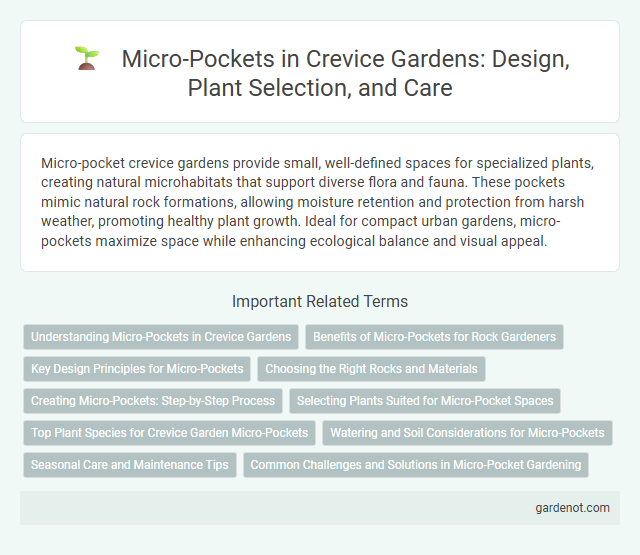Micro-pocket crevice gardens provide small, well-defined spaces for specialized plants, creating natural microhabitats that support diverse flora and fauna. These pockets mimic natural rock formations, allowing moisture retention and protection from harsh weather, promoting healthy plant growth. Ideal for compact urban gardens, micro-pockets maximize space while enhancing ecological balance and visual appeal.
Understanding Micro-Pockets in Crevice Gardens
Micro-pockets in crevice gardens are small, localized depressions or spaces between stones that create unique microhabitats for specialized plants. These micro-pockets trap moisture, nutrients, and provide shelter from wind, facilitating the growth of delicate alpine and drought-tolerant species. Understanding these micro-climates is essential for optimizing plant selection and ensuring the longevity of a crevice garden.
Benefits of Micro-Pockets for Rock Gardeners
Micro-pockets in crevice gardens create ideal microclimates that enhance moisture retention and root protection for succulent and alpine plants. These small recesses improve plant establishment by reducing wind exposure and temperature fluctuations, promoting healthier growth in rocky environments. Rock gardeners benefit from micro-pockets by effectively maximizing their garden's biodiversity and aesthetic appeal through strategic plant placement.
Key Design Principles for Micro-Pockets
Micro-pockets in crevice gardens embrace minimal soil volume and strategic plant arrangement to simulate natural rock fissures, promoting drought-resistant and slow-growing species. Key design principles emphasize precise rock spacing to create narrow, deep planting pockets that retain moisture while ensuring excellent drainage, enhancing microclimate control. Selecting compatible xerophytic plants based on root depth and growth habits maximizes survival and aesthetic harmony within these microhabitats.
Choosing the Right Rocks and Materials
Selecting rocks for a micro-pocket crevice garden involves prioritizing durable, weather-resistant materials such as granite, sandstone, or limestone to ensure longevity and stability. Incorporate a mix of sizes and textures to mimic natural crevice formations and provide suitable microhabitats for plants. Avoid overly porous or fragile stones that may erode quickly under environmental stress, compromising the garden's structure.
Creating Micro-Pockets: Step-by-Step Process
Creating micro-pockets in a crevice garden involves carefully selecting compact spaces between rocks where small plants can thrive. Begin by identifying gaps that retain moisture and provide shelter from wind, then gently loosen the soil within these pockets to enhance root growth. Next, plant suitable species such as succulents or alpine plants that prefer well-drained yet protected environments characteristic of micro-pockets.
Selecting Plants Suited for Micro-Pocket Spaces
Selecting plants suited for micro-pocket spaces involves choosing compact, slow-growing species that thrive in limited soil and moisture conditions. Succulents, small ferns, and dwarf perennials with shallow root systems are ideal for maximizing growth in crevice garden micro-pockets. Emphasizing native and drought-tolerant plants ensures resilience and minimal maintenance in these specialized environments.
Top Plant Species for Crevice Garden Micro-Pockets
Ideal top plant species for crevice garden micro-pockets include drought-tolerant alpine plants such as Sedum, Saxifraga, and Sempervivum due to their ability to thrive in shallow, well-drained soils with minimal nutrients. These succulents and rock-loving perennials exhibit strong root systems that anchor firmly within narrow crevices, maximizing moisture retention and nutrient uptake. Incorporating thyme, phlox, and dwarf conifers enhances biodiversity while providing seasonal blooms and year-round structure in micro-pocket environments.
Watering and Soil Considerations for Micro-Pockets
Micro-pockets in crevice gardens require carefully balanced watering to prevent waterlogging while maintaining consistent moisture for optimal plant growth. Well-draining, nutrient-rich soil with high mineral content ensures healthy root development and supports the unique microclimate of these small planting pockets. Regular monitoring of soil moisture levels and adjusting irrigation frequency based on plant type and weather conditions enhances the sustainability of micro-pockets.
Seasonal Care and Maintenance Tips
Micro-pocket crevice gardens require seasonal care to ensure healthy plant growth and optimal drainage. Remove debris and dead plant material during spring to prevent fungal diseases and improve air circulation. Regularly check soil moisture levels, adjust watering based on seasonal rainfall, and prune plants in late fall to promote strong root systems before winter dormancy.
Common Challenges and Solutions in Micro-Pocket Gardening
Micro-pocket gardening often faces challenges such as limited soil volume, water retention issues, and root space constraints that hinder plant growth. Solutions include using high-quality, well-draining soil mixes, incorporating water-retentive materials like coconut coir, and selecting compact, drought-tolerant plants to maximize survival and productivity. Efficient irrigation systems and regular monitoring of moisture levels also help maintain optimal growing conditions in confined micro-pocket spaces.
Micro-pocket Infographic

 gardenot.com
gardenot.com